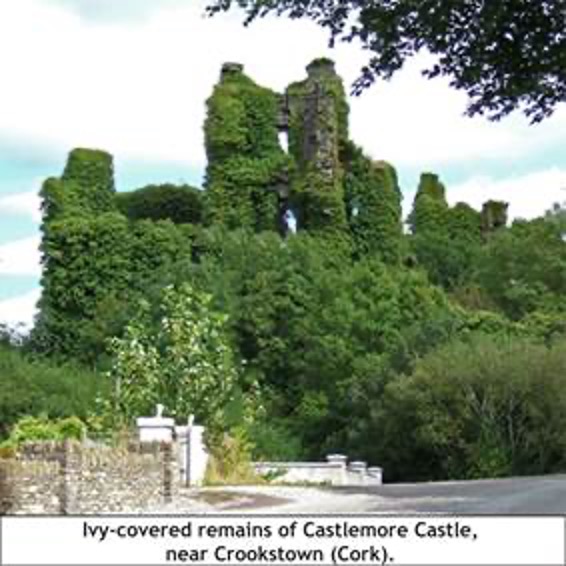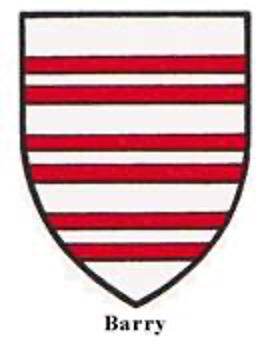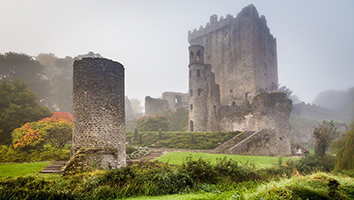Families in Cork and Kerry that held Lordships, etc. from The Earls of Desmond
Fitzgerald
The MacCarthy Mors claimed all the territories occupied by the ‘invaders’ (Anglo-Normans) and those included the large territory of the FitzGeralds, Earls of Desmond. The MacCarthys were often at war with them, over the lands and what was due in chief rent to whom. The Earls of Desmond (FitzGeralds) of course became totally gaelicised and indeed rebelled strongly against the British governments, losing all in the end. And it should be noted that often there was friendly interaction with the Kings of Desmond: for example the wife of the last MacCarthy Mor was a sister of the then Earl of Desmond!! Therefore, it is proper to mention the families which held lands within the territories controlled by the Earls of Desmond for centuries, Gaelic or Norman-Irish, or otherwise. All those families are likewise invited to be part of this Association of the Irish Kingdom of Desmond.

Among the families which held lands of the Earls of Desmond were:
- the FitzMaurices, Lords of Lixhaw (Kerry);
- the Knights of Kerry, Glin, and the White Knight (all creations of the Earl of Desmond for branches of the FitzGerald family);
- the O Dubhagain’s (Duggan, Dugan) who were extremely loyal to the Earls, to include giving their protection to the last Earl, and to the ‘Sugan Earl’ James;
- the Condons (originally deCaunteton) gaelicised Norman-Irish who were a fierce soldierly family, having fought against every side at one time or another! They had Cregg Castle and their chief residence was Cloghleigh Castle near Kilworth – where the Captain-of-the-Nation lived. They also had castles at Carrigabrick and Caherdrinny, near Mitchelstown. They supported the Earl in his 1581 rebellion against the English, and eventually lost everything in the 17th century wars. For much on the two Desmond rebellions, see John Dorney, ‘The Desmond Rebellion’ which was published in two parts on the website of THE IRISH STORY, in late 2015.
Before continuing, it should be mentioned that the 29th Knight of Kerry passed away in September 2011. The Knight of Kerry is alive and well and devoted to Irish interests as was the late Knight of Glin. The line of the White Knight (called FitzGibbon) is, to our knowledge, extinct. And of course the major landholding family within the Earl of Desmond’s territories (or claimed by him) were the Roches of Castletownroche, also very early Norman-Irish intruders into Cork.
- The Roches will be covered separately on a page which follows.
- Then of course there were the FitzGerald Seneschals of Imokilly, with their main residence at Castlemartyr. They were FitzGeralds descended from the Knights of Kerry. Just about all the families holding from the Earls of Desmond lost their lands when he rebelled or during the wars of the 17th century. There were other Fitzgerald branches in Cork, including those of:
- Cloyne;
- Orrery & Kilmore;
- Mallow;
- and Kinnatalloon
all of whom built castles at one time or another.
- There were also families called ‘O Desmond’ in East Cork, and some say they may either have been Gaelic at origin, or a junior branch of the FitzGeralds, or both.
- And there were some branches of the Barretts of Barrett’s Country who were periodically in due to the Earls of Desmond.
- There was a small branch of the famous Norman-Irish family of De la Poer (Power) which very early on had received lands from the FitzGeralds who had received them from Robert FitzStephen as part of the original ‘English grants’. This was shortly after the Norman invasion, in 1185, and around what is now Shanagarry. The Powers built the castle and indeed were Lords of Shanagarry. They thus survived there in direct succession from the 12th to the middle of the17th century, and were gaelicised, before Cromwell demolished them. It is interesting that William Penn, the Quaker founder of the Pennsylvania in the U.S. later received these lands and lived there for a period.
- As to the deCogan family, much of what came to be lands of the Earl of Desmond stemmed as said originally from the (unlawful) grant of King Henry II of England to FitzStephen and deCogan, who had entered Ireland with the invasion of ‘Strongbow’. This grant was of the Kingdom of Cork of the MacCarthys!! While ‘speculative’ of course, deCogans managed to control lands near Cork City and Kinsale (and by another grant of 1207 a deCogan received lands in Muskerry, fighting against the MacCarthys).
The family controlled castles such as their principal at:
- Castlemore;
- and others at Aglish;
- Maglin; and
- Carrigrohane.
They lost most of their lands to the FitzGeralds by the late 13th century and settled at Mora (Mourne Abbey). All their previous castles and lands passed to other families within Muskerry. And their decline continued, aided by raids from fellow Norman-Irish Barrys and Roches, and in 1439 the then deCogan granted all his remaining lands to the Earl of Desmond in return for protection. These lands included Carrigaline, and the then Chief-of-Name took up his residence at Barnahely Castle, near Ringaskiddy, which was referred to as the Lordship of Barnahely. Outlawed in the Cromwellian war and then for supporting King James II, the family lost everything. There are still deCogans today in the Carrigaline area. It should be noted that Carrigaline came originally to the deCogans by a marriage with a daughter of Prendergast, who had received it and lands around including Douglas from King John. Sir Maurice de Prendergast was among the very first knights ashore in 1169, being with Robert FitzStephen. There were conflicting claims to Carrigaline between the Earls of Desmond and the Lords of Muskerry.

Nagle

O Hennessy
Noonan
The O Nunain (Noonan) family, which stemmed from the Dal Cais, and some were located in the Freemount area of Duhallow. They supported the Condons as soldiers and later the Earls of Desmond. They were Lords of Castle Lishen (Kilbolane parish), and lost their lands during the 17th century wars.
Ahern
The Ahern family, also stemmed from the Dal Cais. They were followers of the Lords Roche and clustered in the small barony of Kinnatalloon, with the Chief-of-Name being referred to as of ‘Mogeely’. Some Aherns served as Gallowglass to include some service to the MacCarthys of Muskerry. Losing all in the 17th century, the family also provided some distinguished Wild Geese. And then there was the family of Cotter who were also historically dependent upon the Earls of Desmond. Of Norse/Viking origin, they were in the City of Cork before the Norman invasions off 1169-72. Later, they were Catholic followers of the FitzGeralds and important in Imokilly, where they were regarded as Lords of Coppingerstown Castle, near Midleton. The senior Cotters were loyal to English King Charles II and the Chief-of-Name received a knighthood from King James II, and was made Governor of Cork City. They of course then lost everything in the Williamite War. Later the senior Cotter was hung on a trumped up charge in Cork City, in 1720. They were a totally gaelicised family of much achievement. It is unknown as to whether there is a Chief-of-Name today.
Cotter
And then there was the family of Cotter who were also historically dependent upon the Earls of Desmond. Of Norse/Viking origin, they were in the City of Cork before the Norman invasions off 1169-72. Later, they were Catholic followers of the FitzGeralds and important in Imokilly, where they were regarded as Lords of Coppingerstown Castle, near Midleton. The senior Cotters were loyal to English King Charles II and the Chief-of-Name received a knighthood from King James II, and was made Governor of Cork City. They of course then lost everything in the Williamite War. Later the senior Cotter was hung on a trumped up charge in Cork City, in 1720. They were a totally gaelicised family of much achievement. It is unknown as to whether there is a Chief-of-Name today.
The Roches of Fermoy, etc.

A Roche received a 1207 grant from King John of lands in the Rosscarbery area of Cork, and they also received lands around Fermoy. There indeed was a Roche bishop of Limerick by 1275. For centuries the Roches fought against their neighbours the Condons. Castletownroche became the principal dwelling of the main branch of the family, which received the title of Viscount Fermoy by 1490, though they had been for long beforehand regarded as lords of their country. They became largely ‘gaelicised’ and intermarried with all the titled families, e.g. to a daughter of a MacCarthy Mor and to a daughter of an Earl of Desmond. Technically under the Earls of Desmond (but much disputed), they did not join in the Desmond rebellions. But nevertheless were not trusted by the government.
By 1582 they were still warring against the Condons (two sons of the then Lord Roche were killed). The Lord and other Roches joined the O Neill Rebellion initially, but switched to the English government side before the Battle of Kinsale (1600-01). Remaining Catholic, the Chief-of-Name Lord Roche joined the Irish-Confederate cause after 1641, and for the first time in centuries that found the Roches fighting side-by-side with the Condons! After the war the Roches lost all their lands with the Lord being transplanted in a penniless state to Connaught, receiving barren lands. But he was later granted a pension by Charles II and the Lord served with other Roches in the Army of King James, again losing everything. The title was forfeited by 1703. It should be noted that the current title of Baron of Fermoy (grant by the British crown in 1856) relates to a distaff branch of the original family. Numerous Roches came to spread throughout County Cork and most lost out in the 17th century wars. They are also survived by numerous placenames in Cork, which testify to their remarkable influence on Irish and Cork history. The castles they built are also numerous. There were a number of subordinate families, to include the Walls, another Norman-Irish family, who were Lords of Wallstown north of Castletownroche.
Barrys of East Cork, etc.

The Barrys established manors at Buttevant and Carrigtwohill by early in the 13th century, as well as at Castlelyons and Liscarrol. They were active against the Gaels and against fellow Normans neighbours during the early centuries, but did supply many clerics and much endowment to the church. They came to hold their lands direct from the Anglo-Norman King (or ‘in capite’) by 1336. And in time became ‘gaelicised’. In time, for they were often at odds with the native Irish, for emample: In 1374 the Barrys killed the MacCarthy Prince of Muskerry. The favour was repaid by the MacCarthy Prince of Duhallow at Christmas in 1486, when he killed the then Lord Barry, Baron of Barryscourt.
There were two other major junior branches of the Barrys by then, in West Cork and known as Barryoge and Barryroe (as has been covered under the section of the MacCarthy Princes of Carbery previously). The main branch had its primary castle at Barryscourt in East Cork and when the 16th lord died in 1558 without male children the Barryroe branch succeeded to the overall chiefship of the name and of the family, though not without opposition from Barrys in Barrymore who were more closely related to the last lord.
The Lord Barry aided the Earl of Desmond in his uprising of 1581-83 but did not lose his lands, though some junior branch Barrys in Barrymore did. The Lords Barry no longer went against the English government and did not join O Neill’s rebellion. When O Neill entered Munster he indeed devastated the lands of Lord Barry for his refusal to join the nationalist crusade. Many of the Barrys did indeed join the rebellion though the Chief-of-Name was on the side of the English government at the Battle of Kinsale. The Lord Barry for his loyalty was made Earl of Barrymore in 1627. And, he sided against the Catholic and Irish nationalist / legitimate king side in the war starting with the 1641 Irish uprising, having also officially turned Protestant shortly before.
The then Earl of Barrymore likewise did not support Catholic King James II in 1689. But mismanagement and other problems caused the Lords Barrymore to sell or mortgage their lands, and they had little left when the last Earl died in 1824 and the main line became extinct. The Barrycourt castle has been largely refurbished through private initiative starting in the late 20th century.
Junior Branches of the Barrys in Barrymore, etc.
There were many junior branches of the main line which continued to hold the old religion (Catholic) and to flourish. Those Barrymore Barrys flocked to the Catholic and nationalist side in all the wars, and many suffered confiscations. These junior branches were certainly ‘gaelicised’ and were with few parallels in terms of their Irish nationalism and devotion. Let us capture them, as follows:
- The Barrys of Dungovrney. This branch came from a younger son of a Lord Barry circa 1300 and their principal place was the castle of Dungourney. They lost their lands for rebellion after 1641.
- The Barrys of Leamlara were another ancient branch, and had a castle at Leamlara by the 14th century. The family lost much in the wars of the 17th century.
- The Barrys of Lisnagar, Rathcormack, called the MacAdam Barrys were another branch of great antiquity, and managed to hold on to their lands even after being outlawed in 1690.
- The Barrys of Annagh, Churchtown parish, were known as the FitzJames Barrys. They were descended from a younger son of the 1st Lord of Ibawne. Their castle was called Annagh Castle and it figured prominently in the wars starting in 1641, and their lands were all confiscated by their further participation with King James II in 1689-91.
- The Barrys of Ballyclogh, near Mallow. Their estates were forfeited after 1641, and further Barrys of the Mallow area were outlawed in 1690.
- The Barrys of Rathbarry (later Garranekinnefeake) were another junior branch.
- The Barrys of Ballinaltig, barony of Ballyclogh were descended from number 6 above.
- The Barrys of Dundullerick and Rahanisky were descended from a brother in the family of the West Cork Lords Barryroe. Their castles were at Ballyrobert and at Rahanisky, all confiscated by the Cromwellians. Restored by King Charles II circa 1661, this Barry family again lost everything for following King James II in 1689. But a member of the family managed to hold on to Dundullerick House as the family residence into modern times.
The contributions of the Barry family to the cause of Irish freedom are too numerous to list, though well-known to all Irish people. The junior branches above all had ‘chieftains’ of their branch of the name, though it appears no Barry has claimed such. The Association also believes that a bloodline descent from a senior branch can be proved with effort, and that that line would have the right to the overall Chief-of-Name designation, as Lord of Barryscourt. But this time as part of the overall now titular Kingdom of Desmond of the MacCarthy Mors, and not as part of something illegally awarded and taken by conquest in the 12th century.
Walsh
O Leahy
Another family noted in East Cork is that of O Leahy, also followers of the various Barrys, and also losers of much in the wars. There were O Leahy ‘Wild Geese’ and a branch of the family was located in County Kerry. And there is note of the family of Mulcahy (O Maolchatha) which had also been noted in County Kerry in earlier centuries as well. A Philip Mulcahy is noted in the Down Survey pre-Cromwell, as having lands at Lackendarragh North, Middle, and South – not far from Rathcormac or Fermoy.


